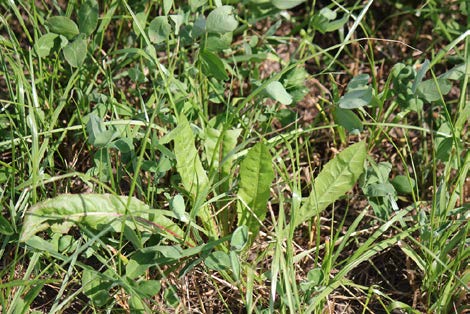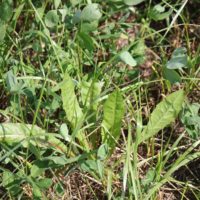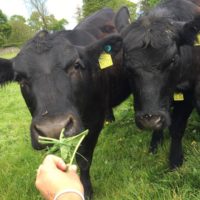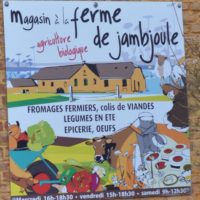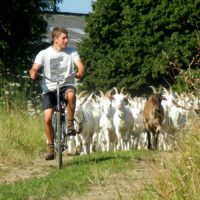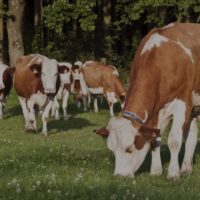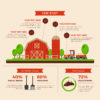Description
Background
Mr. Grzegorz Łuczak together with his wife runs a small farm located in the central part of Poland in the village Woźniaków near the town Kutno. The farmer’s main idea for farm running is to produce high-quality milk and process it to dairy products sold directly from the farm. He and his wife were a typical full-time working people when someday they decided to start their own business. They always wanted to get back to their childhood when they were living in the countryside and were recalling the food that was produced by their grandparents in those times, its flavor values and quality impregnable nowadays. Thanks to those memories they decided to buy a small farm in the nearby village and start to produce milk from a few dairy cows. In that time they have been treating it as a hobby and still were working in theirs jobs. From the beginning they decided to process the obtained milk into different dairy products and sell them directly from the farm. Farm produces a wide assortment of dairy products: fresh milk, butter, cream, kefir, yogurt in different flavors, cottage cheese, cream cheese, short and long-ripening cheese. The entire obtained profit was invested back to the farm and the equipment for the milk processing. In that way today Mr. Łuczak and his wife are working only on the farm and processing milk into many different dairy products. They are farming on an area of 20 hectares of agricultural land and in the moment of creating this case study they were mainly used as grasslands. The forage production is based on 12 hectares of permanent grasslands where the botanical composition is dominated by Lolium perenne, Festuca pratensis, Dactylis glomerata, Phleum pratense, Trifolium pratense. The 8 hectares of arable land owned by the farmer are equally sown by alfalfa to obtain forage with higher content of proteins and by grass-legume mixtures. The whole plant production is free from chemicals and is kept on a very extensive level for obtaining the best quality of forage. The farm herd is based on 11 milk cows and with the young ones is 14,7 LU big. There are kept animals of few different breeds: Holstein Friesian, Brown Swiss, Montbeliarde, Meuse-Rhine-Issel and their crosses. The average amount of milk obtained from cow is 7500 liters per year. The herd is also part of a scientific project in which, under a specially prepared breeding program and chemical analysis of milk, the selection of cows was implemented, which produce milk with altered protein composition, thanks to which the obtained product will have a less allergenic effect. The farmer is consistently searching for different solutions, ideas and innovations to obtain the best milk for processing and increasing quality of flavor values and in the end high price for his dairy products. He is aware that a large part of the quality of milk can be obtained on grassland and the quality of the produced forage.
Detailed description
In order to obtain the best quality of forage produced on grasslands, the farmer was searching not only for a solution how to increase their productivity but at the same time he wanted to obtain forage with a higher quality and nutrition value. Thanks to his own curiosity and determination, he found out that he can achieve those goals towards changes in the botanical composition of the grassland sward. Introducing new productive and valuable species of grasses can increase productivity and herbs can increase the nutrition value of the obtained fodder. The idea of introducing herbs to grassland sward with the aim to produce high-quality forage was taken from the literature and practice of other organic farms in Poland and Europe. The main problem during the implementation of this innovation was the lack of herbal seed mixtures for grassland establishment on the domestic market, especially for the production of feed for dairy cattle. The solution that turned out was the available herbal seed mixtures for horse pastures renovation. One of the Polish seed companies has in theirs offers an herbal mixture composed out of Carum carvi, Cichorium intybus, Sanguisorba officinalis, Foeniculum vulgare, Petroselinum crispum, Plantago lanceolata, Achillea millefolium, Pimpinella saxifraga, Daucus carota, and Galium verum. The farmer uses the seeds as a supplement for grass-legume seed mixtures by grassland establishment and renovation. The increased production of milk has given the farm a possibility to get larger amounts of the dairy products that can be sold to consumers. To increase the sales range farmer participates in a sales project based on a website (lokalnyrolnik.pl) where customers can order the products from local farmers and make their payment. In this way the farmer knows the amount and type of the product to prepare. There is also prepared a logistic chain the farmer is obligated to transport his product to a central warehouse located in few Polish cities. There are prepared boxes with different products, which are delivered to the place pointed by the customer (preferable are places where boxes can be picked up by few customers e.g. greengrocer, kindergarten).
Results
Meadow herbs in the sward are included in the mixture for improvement of the quality of obtained feed, finally affecting the better milk quality. Meadow herbs in the herbage have also a positive effect on animal health and welfare. Innovation allows the farm to improve the health and welfare of animals and obtain high-quality milk necessary for its processing on the farm in order to obtain final high-quality dairy products for direct marketing. The multi-species mixtures can also increase the tastiness of the forage and efficiency of feed utilization. The quality of raw milk is of high importance in the production of dairy farm products, especially long-term ripened cheese. Valuable herbage from grassland used in dairy cows feeding allows obtaining milk with a significantly reduced content of unfavorable micro-organisms from the Clostridium group and others in relation to milk based on maize silage. Such milk is desirable for long-term ripened cheese production. The presence of herbs has also an environmental cause increasing the biodiversity of the grasslands.
Adoption criteria
Innovation implemented in the farm can be easily adapted by other farmers producing high-quality milk. Renovation of grasslands is one of the most important treatments for maintaining theirs productivity. The introduction of herbs in the botanical composition can be made just by adding them to the sown standard mixture. The presence of herbs in the sward can not only be valuable for the quality of the milk but the increased nutrition value of the forage can give a preventive bonus in the animal welfare and healthiness.
Future prospects
At this moment the farmer is in the first year of the innovation implementation and just started to feed cows with the new forage. He can`t objectively comment about the obtained yields because due the drought year the grasslands didn’t show their potential. He admits that the obtained forage is willingly eaten by the cows and he observes that they are searching for the haylage parts containing herbs. The farmer is looking also for improvement of the composition of sowing mixture that will be typically prepared for dairy cows. One of the biggest problems is the availability of seeds of the different herbs. The reproduction of such species is not carried out in Poland so they need to be bought in foreign countries.

